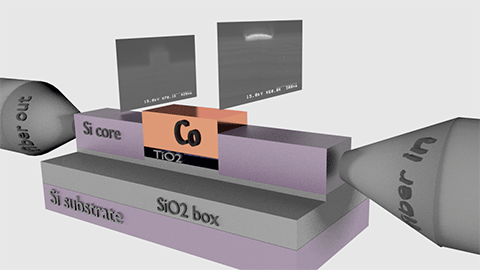Dr. Vadym Zayets
v.zayets(at)gmail.com
My Research and Inventions
click here to see all content |

Dr. Vadym Zayetsv.zayets(at)gmail.com |
|
 |
IntroductionSi nanowire fabrication technology fiber/waveguide coupling setup integration: plasmonic + Si waveguides Out-plane plasmonic confinement AlGaAs waveguide (800 nm)in-plane confinement of plasmons
IntroductionSi nanowire fabrication technology fiber/waveguide coupling setup integration: plasmonic + Si waveguides Out-plane plasmonic confinement AlGaAs waveguide (800 nm)in-plane confinement of plasmons
|
Integration of Si nanowire waveguides and plasmonic waveguides
Technology
Why it is important?The integration of different optical components on one substrate has many benefits. Similar to electronic devices, an integrated optical circuit may have a lower cost and better functionality. The size of MOSFET transistors are very small and millions of the transistors can be integrated into one electrical circuit. In contrast, the size of optical components is not as small. The typical length of optical components is about a millimeter and only a few optical components can be integrated into one chip. The length of optical components is limited by the wavelength of light. The size of optical elements can be reduced when Si nanowire waveguides or/and plasmonic waveguides are used. The optical confinement in a Si nanowire waveguide is strong, because of a high refractive index contrast. Due to strong optical confinement, the Si nanowire waveguides are very narrow with width of 450 nm and they can sharply bend with bending radius as small as 1 mm. Even though the length of Si-nanowire devices has to be still relatively long, by bending the optical device can be packed into small area of a few um2.
Key points of the technology1. Loss reduction for plasmonic waveguidesA metal is essential material of a plasmonic waveguide. Any metal significantly absorbs light. Therefore, some optical loss is unavoidable in a plasmonic waveguide. In case if this loss is too large, all light is absorbed in plasmonic waveguide. Even if such plasmonic waveguide might have an unique property, it has no any practical use. The length of a plasmonic waveguide is about 1-50 um. The device loss of 3-5 dB is acceptable. The loss of plasmonic waveguide should be at least smaller than 1 dB/um. The loss of 0.1 dB/um is a small loss. Of cause, the length of plasmonic waveguide is fixed by the effect for which the plasmonic waveguides is used. Usually, there is a trade-off between there is trade-off between the strength used effect and the optical loss. For example, a higher isolation or stronger electro-optical conversion or magneto-optical conversion occurs in a plasmonic waveguide of higher loss.
2. Improving of coupling efficiency between Si-nanowire and plasmonic waveguidesThe coupling efficiency better than 1 dB/facet is desirable.
Serial and Parallel Integration of a plasmonic and a Si nanowire waveguides.more in page on plasmonic isolator (1) Serial integrationIn this case the plasmonic waveguides blocks the light propagation in Si nanowire waveguides. Light can reach output only in a case when a plasmon is excited. (See Fig. 1 and Fig.2) Technology: - Wedge-, bridge- or grove- types of plasmonic waveguides should be used. The confinement by a metal stripe should be avoided. -Lift-off process can be used for a metal micro fabrication . Merits: - Properties of a plasmon (MO effect, electro-optical effect) significantly influence the output light, because light can reach output only by excitation of a plasmon Difficulties: - Coupling efficiency between plasmonic and Si waveguides should be maximized (difficult) -Propagation loss of plasmon should be minimized
(2) Integration in Parallel
In this case the plasmonic waveguides is integrated aside of a Si waveguide and the direct propagation of light is not blocked in Si waveguide. Only a resonance coupling in/out of a plasmonic waveguide only affects the output. It is similar to a ring resonator, where a ring is fabricated aside of a straight Si waveguide. Technology: - The etching by the Ar-milling should be used for for a metal micro fabrication. The lift-off process should be avoided -A combination of bridge-type and metal-stripe type of a plasmonic waveguide should be used. Merits: - A high coupling efficiency between plasmonic and Si waveguides is not as critical as in the case of the serial integration -A low propagation loss of plasmon is not as critical as in the case of the serial integration.
Difficulties: - - Unique properties of a plasmon (MO effect, electro-optical effect) affect only a little the output light. The influence is stronger only in a case of a resonance coupling of light into the plasmonic waveguide. -
Technology for reduction of propagation loss in plasmonic waveguides :
|
|
||||
Note: the fiber-to-fiber transmission includes:
click on image to enlarge it TM0 mode is excited in Si waveguide |
Technology (2 steps):
(1) A narrow bridge of Si between Si waveguides is fabricated at the same when Si nanowire waveguides
Width of bridge is 70-100 nm.
(2) the bridge is covered by metal. Width ~1 um. EP with positive resist + lift-off.
It is very effective method for both the reduction of propagation loss and the improving the coupling efficiency
Complexity of fabrication: minimal
Note: The beam current for EB beam should be 50 pA for the bridge, but 400 pA for Si waveguide.
Bridge-type plasmonic See Click on image to enlarge it |
 |
Si nanowire waveguide (450-nm wide) are connected by bridge waveguide. The width of Si bridge is 100 nm. It is cover by a thin metal
|
Technology (3 steps):
1) A narrow bridge of Si between Si waveguides is fabricated at the same when Si nanowire waveguides. Width 150-250 nm. It is OK to use 400 pA EB current.
2) The bridge is wet-etched and a sharp wedge is formed on the top
3) The wedge is covered by a metal. Width ~1 um. EP with positive resist + lift-off.
Width of bridge is 70-100 nm.
Technology (5 steps):
1) 1-um-wide Si stripe between Si waveguides is fabricated at the same when Si nanowire waveguides
2) A 200-nm wide gap in SiO2 is fabricated on top of the Si stripe. EB with negative resist+ SiO2 sputtering+ lift-off.
3) The si is wet-etched through the gap
4) SiO2 mask is wet etched by BHF.
5) The grove is covered by a metal. Width ~1 um. EP with positive resist + lift-off.
For a grove-type Co/TiO2/SiO2 plasmonic waveguide I have obtained 1.2 dB/um plasmon propagation loss, which is comparable with bridge and wedge-types plasmonic waveguides.
Fig.5 Integration plasmonic and Si-nanowire waveguides Narrow line of metal is used for lateral confinement. See Click on image to enlarge it |
 |
Cross-section SEM images of sections of plasmonic and Si waveguides are shown. The width of plasmonic and Si waveguides is 450 nm. The height is 220 nm. For some devices ( for example, non-reciprocal coupler) only such lateral confinement is possible. It is challenging to obtain low loss propagation of plasmon in this configuration, because of substantial scattering at edges of metal !!!(See text) |
The simplest technology for lateral confinement of a plasmon. Often the optical loss of plasmons for the stripe confinement is very high.
For example:
I have fabricated several Co/TiO2/SiO2 plasmonic waveguides on Si using Co stripe. Even though double-layer TiO2/SiO2 is proved to efficient for loss reduction, the optical loss in plasmonic structure with a Co stripe was unacceptably high about 10-15 dB/um.
The loss was so high, I could see no output even for short 8-um plasmonic waveguides. In case when instead I have used either a bridge or wedge or groove -type of plasmonic waveguide a lot of light comes out. The improvement is so obvious!!!
The reason of a high loss in a stripe-type plasmonic was found to be the optical scattering at the edges of the metal stripe. In order to integrate a plasmonic waveguide with a Si nanowire waveguide, the metal stripe should be narrow about 450 nm. In the case of a narrow plasmonic waveguide the scattering at metal edges becomes a major mechanism of optical loss. In order to avoid it, another method for in-plane confinement should be used, which could ensure the confinement of a plasmon out of metal edges.
 I am very thankful to Dr. A. Baryshev
I am very thankful to Dr. A. Baryshev and Dr. A.M. Merzlikin
and Dr. A.M. Merzlikin ![]() for many suggestions on wedge and groove plasmonic waveguides
for many suggestions on wedge and groove plasmonic waveguides
Bad lift-off causes high plasmon-propagation loss See Click on image to enlarge it |
 |
Because of a high refractive-index contrast between a metal and a dielectric, the scattering loss at the edge of the metal can be huge!! Huge plasmonic loss is originated from a bad lift-off + metal-stripe confinement. |
The metal cover of a plasmonic waveguide can be fabricated ether by
1) positive EB resist + lift-off.
2) negative EB resist + etching by Ar milling
------------------------------------
Note: in case (1) the method of double resist (EB resist +LOR) should be used. The use of a lift-off machine is preferable.
Note: It is difficult to etch a metal film thicker than 100-200 nm
---------------------------------------------------------------------
 It is important. The edge of metal is much smoother when the etching is used instead of the lift-off!!!
It is important. The edge of metal is much smoother when the etching is used instead of the lift-off!!!
I will try to answer your questions as soon as possible